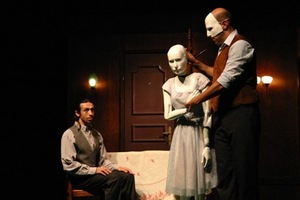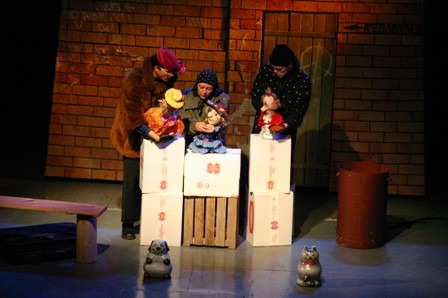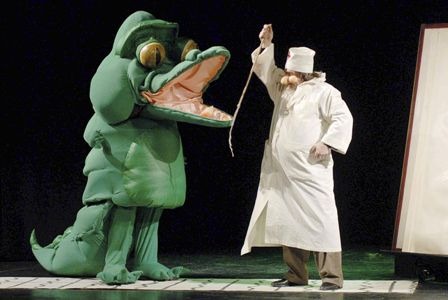ABOUT PUPPET THEATRE, IF I CAN… 0
(A look of a young theatre critic to the 17th international festival of puppet theatres “Smiling Puppets and Children” in Kaunas) Margarita Pilkaitė
www.kamane.lt, 2007 05 31
Israel. "Story of a Lonely Man"
Gardin. "Miraculous Ring"
Vilnius. "Doctor Dolittle" . Photos by Sigitas Klibavičius
In brief: Traditionally the majority of theatrical people and spectators of the “serious” theatre look at the puppet theatre from above – different scale, not such deep dramaturgy, not so famous direction. Puppeteers live somewhere in the outskirts of the great theatrical world, and the puppet theatre is considered to be an attraction rather than serious stage art.
It is due to puppets – they are pictured as lifeless copies of human beings which may be enjoyed only by children who have not "grown" to real theatre yet. Needlessly. Not everything is so simple here. In order to understand what a puppet in a theatre is, one needs to realise it as a tool of artistic language and a possibility. It is a separate science and art which has thousand-year-strong traditions and which has emerged from magic and religious rituals.
The puppet theatre is not evaluated properly in Lithuania as well; still, it becomes the central event of theatrical life of the country once per year when the festival "Smiling Puppets and Children" is organised in Kaunas. This year the programme of the festival was very colourful and meaningful, it revealed the variety of Eastern and Central Europe, Finland and Israeli puppet theatres as well as the contemporary attitude towards the tendencies and potentials of the puppet theatre.
The programme was started with performances of pupils’ theatres, and works of seven foreign countries representatives were presented in addition to Lithuanian theatres in the festival. Kaunas Puppet Theatre showed the premiere “Small Muck” (dir. Algimantas Stankevičius), a performance in which the stylised puppets of Vitalijus Mazūras and actors controlling them were combined harmoniously. Vilnius theatre Lėlė presented “Doctor Dolittle“ (dir. Rimas Driežis), which was exceptional for the vivid view, expression and humour. The director succeeded to create the atmosphere of a fairy-tale on the stage and in the audience hall.
A different attitude to the puppet theatre was introduced by Thy Teater from Denmark and Vlinders&Co theatre from Belgium. The performance of shadows of Thy Teater “About Alice” looked like a mosaic of colourful shadows which replaced each other, the music was well combined with the performed songs. The spectator could create meanings himself/herself instead of believing in the director’s truths blindly. The performance illustrated the road of Scandinavian puppet theatres towards the abstract and conceptual theatre based on novelties. Meanwhile, the amusing performance of the theatre Vlinders&Co “Utsi-putsi” (dir. Koen Crul) for the smallest spectators was based on the improvisation of actors with domestic tools – brushes, containers, etc. which turned into performers of short stories. The clown Dodo (Jari Siljamaki) from Finland was more subtle – amusing the audience in the street, he attracted small and grown-up spectators.
The revival of puppets or some other thing is the main task of a puppeteer; however, Panevėžys puppet cart theatre did not perform this miracle in “Miraculous Shoes” (dir. Nijolė Indriūnaitė). Beautiful puppets remained lifeless moulages moved by actors. This is an example when the actors did not trust the power of puppets. Meanwhile, Gardin puppet theatre demonstrated a wonderful connection between a puppet and a puppeteer in the charming tale “Miraculous Ring” (dir. Olegas Žiugžda). Byelorussians proved by the performance that the actors really knew how to use the eloquence of a theatrical puppet.
Distrust in the puppet was shown by Bialystok puppet theatre from Poland in the performance “Neverland” (dir. Jacek Malinowski). Impressive scenography, special effects were not sufficient for the performance to be successful. On the other hand, Riga state puppet theatre chose a minimalist scenography and paid much attention to the personification of a thing-puppet in the tale “Miraculous Pipe” (dir. Vija Bluzma). The performance was rhythmical, puppets acted in a persuasive manner but actors could not manage the relation between things and themselves in some places.
Klaipėda puppet theatre offered a subtle and intimate view – the story of Christ’s birth told using kitchen utensils (“Under the Star of Bethlehem. Tale of Utensils”, dir. Gintarė Radvilavičiūtė). It was a perfect example how a well-known story may sound anew. Meanwhile, Mytisci puppet theatre Ogniv from Russia presented a different performance “Star Boy” (dir. Jurij Fridman), in which the acting of marionettes did not last long and the audience was flooded with linguistic information. There was much action on the stage by no answer, what was it for?
The festival was ended by Ofer Amram troupe from Israel which presented the performance for grown-ups “Story of a Lonely Man” (dir. O.Amram). The complicated and dismal performance analyses the eternal truths deeply – loneliness, human nature, passion, creation, pygmalionism, jealousy and revenge. Aesthetical performance reduced to essential actions charmed by the ability to tell the entire life of a human being by minimal images. The puppets joined the world of people masterfully.
The festival also encompassed the creative laboratory headed by the professor of Warsaw Theatre Academy Marek Waszkieli and discussions, in which more attention was allocated to problems of the contemporary puppet theatre. The discussions were moderated by the theatre critics Vida Savičiūnaitė and Ridas Viskauskas, and the participants shared ideas and work experience, considered the strategies of the puppet theatre survival and development during them.
Thus, the festival of puppet theatres was much more complicated and multi-sided than the parade of puppets and masks in Laisvės Alley, which does not represent the mystery of puppeteers’ art embracing various themes, techniques, attitudes and expression means. And – puppets, which become clever at the human will and with which not only children are smiling.



